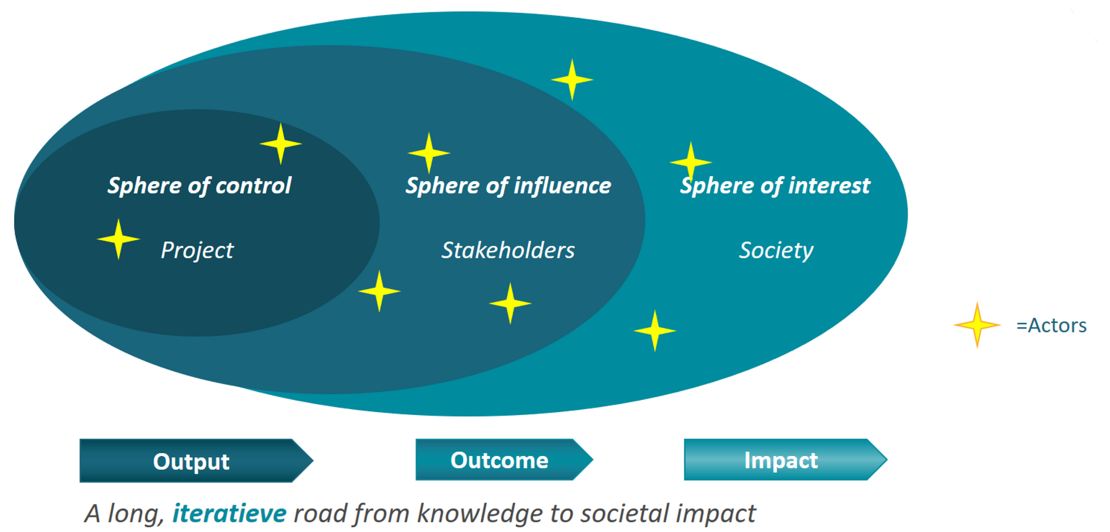Let’s Talk About Impact is a series that explores various aspects of making impact. We strive to make a change for the better, to make an impact, but what lies beyond this buzzword? Today we talk about Impact Pathways and the Sphere of Control, two models that help you visualise and reflect on your impact.
Impact can, in the broadest sense, be described as “the positive and negative, desirable and undesirable, primary and secondary long-term effects produced by your project which can be direct or indirect, intended or unintended.” [1] , or: “a powerful effect that something, especially something new, has on someone or something” [2] . Having an effect on something or someone, highlights change brought about by one’s activities. Talking about impact is a conversation about the lasting change of one’s work, beyond someone just using your work. What changed, because of your work? How to bridge something as concrete as activities to something less tangible like “impact” can be explored using an impact pathway.
Impact Pathway
Using an impact pathway is an effective way to plan for future impact and looking beyond daily activities. An impact pathway tries to bridge what you do (activities) to what a future state where something has changed (impact). You can see this illustrated in the image below, where the steps can be described as:
- Inputs: What academics need (e.g., a grant).
- Activities: What academics do (e.g., literature review, interviews, lab work, surveys).
- Outputs: The products of research (knowledge and tangible “products”, like a publication or prototype)
- Outcomes: People are aware of and are using the outputs (e.g., a healthcare provider using your proposed way of working, or your theory becoming used in a field)
- Impact: effect on… (going beyond usage: what is actually changing? Is the “use” sustained? Who benefits?)
When using an impact pathway, you start at the desired impact and then work your way back. This also fits the Impact by Design approach of the BMS Position Paper on Impact, where impact is a continuous part of our work, not an afterthought. You may also recognise this approach from NWO or Erasmus+ calls for instance.
 Figure: a model impact pathway, adapted from the Erasmus+ Impacttool
Figure: a model impact pathway, adapted from the Erasmus+ Impacttool
Sometimes multiple paths contribute to the same impact. Think of an overarching envisioned impact and multiple work packages contributing to this. Or how your education and research make an impact but sometimes in different ways. As such, you could also “stack” pathways that all lead to a same impact.
We would love to construct a set of example pathways by BMS colleagues. Can we help you construct an impact pathway for your project, work, or research line? This can help you in grant applications, career talks and for your personal satisfaction. By sharing these with the faculty you can inspire others and make the concept of impact tangible.
Sphere of Control
But you can't control everything! Sometimes researchers feel that they are expected to be in control of the impact of their work, across the entire pathway, but this is not the case. The further you are in the impact pathway, the less control you have. This is visualised below. For example, you are in control of the contents of your publication, intervention, or prototype. This is referred to as the sphere of control. Who is citing/using this, is something you can influence by pro-actively sharing your work and involving relevant stakeholders, but you cannot control this. This is referred to as the sphere of influence. When talking about future impact, you can describe how you set up your work so that the chance of future impact is high. This is in the sphere of interest, where you have very little control and the frame of reference is wide (e.g., society, your discipline, …).

Figure: spheres of control, influence and interest, from NWO "Working with an Impact Plan"
Colophon
This series is composed by BMS Research Support. While most content applies to a wider array of disciplines, some may resonate more with a BMS audience. If you work at BMS and have any impact-related questions, reach out to Tom Boogerd. If you work at another faculty, you can still reach out and we can find a colleague of your faculty who can help.
For this episode we built on work from:
[1] faculty ITC, who based their definition on the work of HIVOS
[2] The Cambridge Dictionary
This news item is also available as a page on our website.

